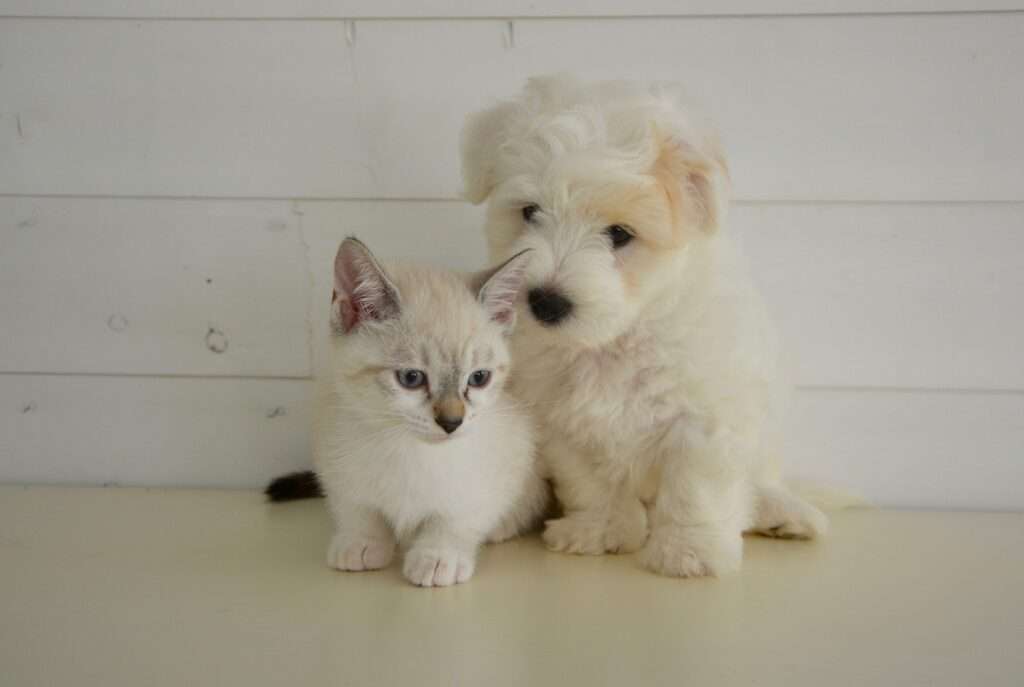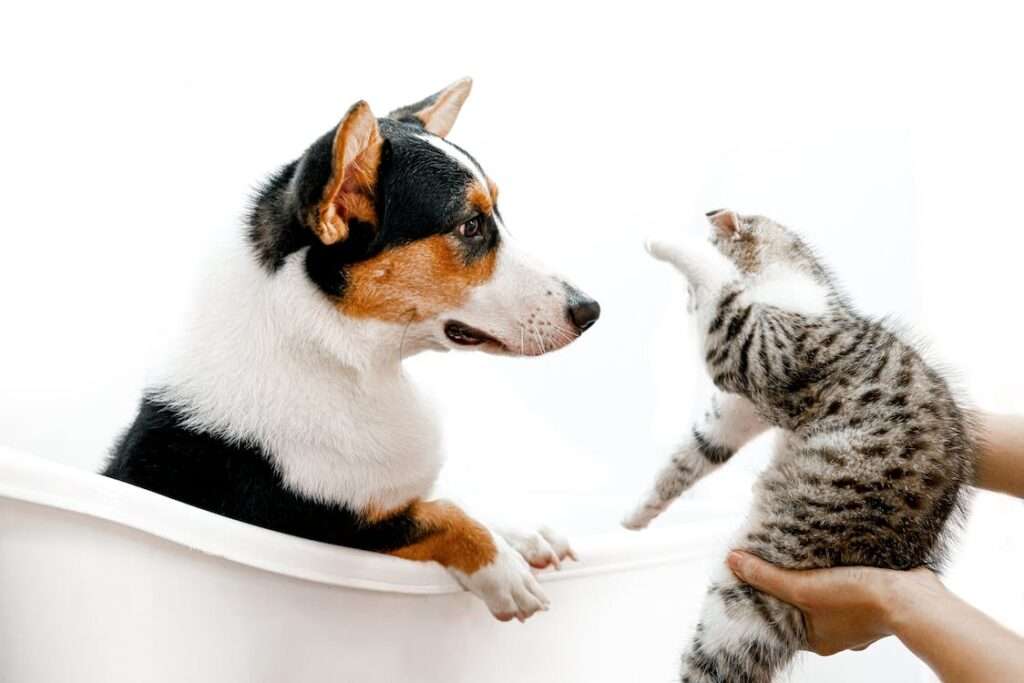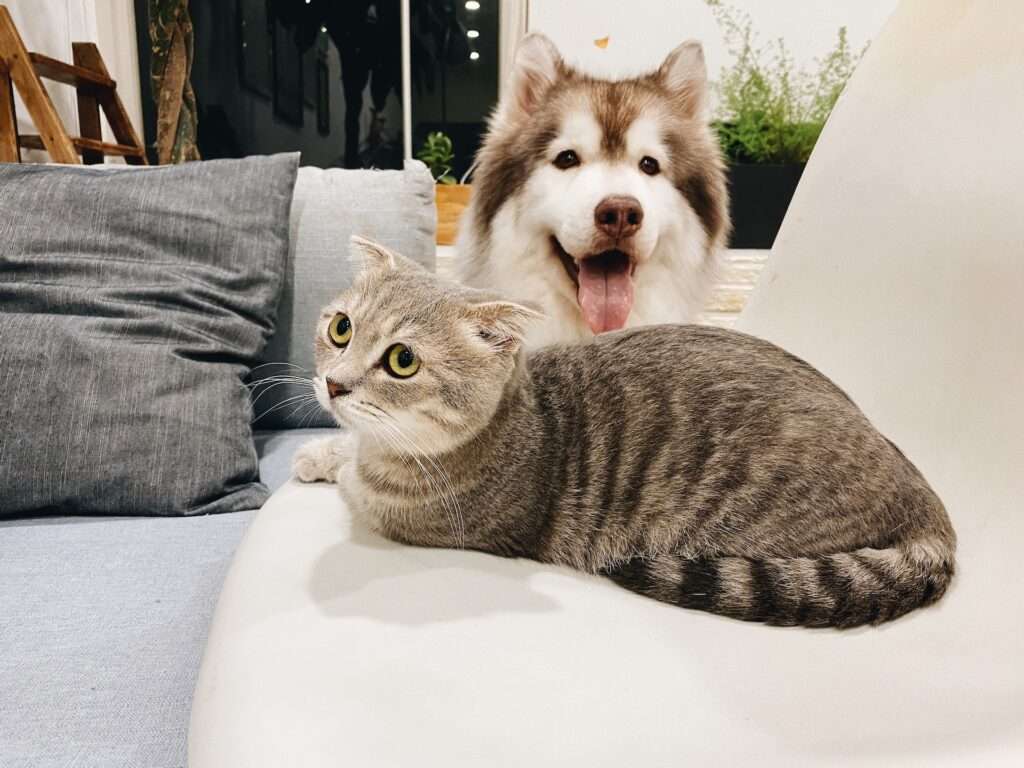Why Do Dogs Hate Cats? Exploring the Root Causes and Solutions
Are dogs and cats destined to be sworn enemies? Let’s debunk the myth and unlock the secret to a harmonious coexistence! As a pet owner, you might have wondered why these furry friends often clash and how you can bring peace to your household. Fear not, for we’re here to guide you through the maze of instincts, socialization, and behavioral differences that shape their relationship.
Discover the fascinating world of dogs and cats as we uncover the hidden truths behind their perceived animosity. From the primal instincts that drive their actions to the power of early socialization, we’ll equip you with the knowledge and tools to create a sanctuary where harmony prevails.
Say goodbye to the age-old feud and embrace a future where dogs and cats not only coexist but thrive together as lifelong friends. Let’s embark on this adventure together, where tails wag and purrs harmonize—because in the world of pets, peace is always possible.
The Instincts of Dogs and Cats
Dogs and cats, despite being beloved pets worldwide, can sometimes find themselves at odds due to their inherent instincts. Understanding these natural tendencies can greatly help in fostering a harmonious relationship between them.
Dogs, descendants of wolves, have a strong pack mentality ingrained in their DNA. This can make them perceive cats as potential prey and trigger their hunting instincts. The urge to chase or hunt may arise even when dogs are raised alongside cats from a young age. On the other hand, cats are natural predators with a territorial nature. They may view dogs as rivals for resources such as food and territory.
These contrasting instincts can create tension between dogs and cats. However, with careful guidance and proper introductions, dogs and cats can learn to coexist peacefully. Building a solid foundation of understanding and providing a safe environment is crucial for their successful interaction.
Through recognizing the innate instincts of dogs and cats, we can take proactive steps to help them establish a positive relationship. Patiently guiding their interactions, providing separate spaces for them to retreat to, and rewarding calm behavior are essential in fostering mutual respect and minimizing conflicts.
The Importance of Socialization

Socialization plays a crucial role in raising well-adjusted pets and is particularly important when it comes to fostering positive interactions between dogs and cats. By introducing them to each other from a young age, you can establish a foundation of harmony that will benefit them throughout their lives.
Early socialization is key. When your pets are still young puppies or kittens, it’s the perfect time to expose them to each other under controlled circumstances. Supervised play sessions allow them to interact and learn appropriate behaviors in a safe environment.
Lack of socialization can contribute to a dog’s aversion towards cats. If a dog has never been exposed to feline friends before, they may find them unfamiliar or even threatening. In such cases, gradual and cautious introductions are crucial. Positive reinforcement techniques can be employed to create positive associations, helping the dog develop acceptance and even friendship towards their feline companion.
When you prioritize socialization, you are providing your pets with the necessary tools to navigate their interactions with grace and ease. It is through early and ongoing exposure that dogs and cats can learn to understand and appreciate each other’s boundaries, leading to a happier and more harmonious household.
Behavioral Differences Between Dogs and Cats
Dogs and cats possess distinct behavioral differences that can sometimes create challenges in their coexistence. Understanding and addressing these differences are key to promoting a harmonious relationship between the two species.
Dogs are known for their social nature and strong desire for attention and interaction with their human companions. They thrive on companionship and often seek opportunities to engage in play or other activities. Cats, on the other hand, tend to exhibit more independent behavior. They appreciate their personal space and may prefer solitude at times, valuing moments of tranquility and relaxation.
These divergent behavioral tendencies can lead to potential conflicts between dogs and cats if not properly managed or if socialization has been lacking. Dogs may eagerly seek interaction with cats, not realizing that their feline counterparts may feel threatened or overwhelmed by their exuberance.
To foster a peaceful coexistence, it’s crucial to recognize these behavioral disparities and provide your pets with the appropriate resources and spaces they require. Offering separate areas where each pet can retreat when needed helps ensure they have their own personal havens. Additionally, providing ample opportunities for exercise and mental stimulation for both dogs and cats is essential for their overall well-being and contentment.
By acknowledging and accommodating the individual behavioral needs of dogs and cats, you can create an environment where they can thrive together. Striking the right balance between social interaction and personal space will contribute to a more tranquil and joyful coexistence between these cherished members of your family.
Prior Experiences and Trauma

Prior experiences and trauma can significantly impact a dog’s behavior towards cats. Negative encounters, such as past attacks or scratches from cats, can leave a lasting impression, leading to aversion or fear towards feline companions.
Addressing these experiences is crucial for fostering a positive relationship between your pets. By creating new, positive associations, you can help your dog overcome their fear or aversion towards cats. Positive reinforcement techniques, like rewarding calm behavior around cats, can be instrumental in this process.
Gradual introductions in a controlled and safe environment allow your dog to acclimate to the presence of cats at their own pace. In cases where trauma or negative experiences have deeply affected your dog, seeking professional help may be necessary. Certified dog trainers or animal behaviorists possess the expertise to address specific traumas and guide your pets towards peaceful coexistence.
Their specialized knowledge and support can make a world of difference in helping your dog overcome past challenges and develop a positive outlook on interactions with cats. With patience, understanding, and professional assistance when needed, you can help your pets move past their prior experiences and create a harmonious bond that transcends any past trauma.
Breed-Specific Tendencies
Breed-specific tendencies can have an impact on a dog’s dynamics with cats. Certain breeds, like terriers and hounds, were selectively bred for their hunting instincts, which can manifest as a stronger prey drive. This heightened instinct may pose challenges when it comes to establishing a peaceful coexistence with cats.
However, it’s essential to recognize that each dog is unique and may not conform strictly to breed stereotypes. While some breeds may have inherent tendencies, individual personality and early experiences can greatly influence a dog’s behavior towards cats.
Early socialization and training are instrumental in mitigating breed-specific tendencies and improving the relationship between your dog and cats. By exposing them to positive interactions with cats from an early age and providing consistent training, you can help your dog develop appropriate behaviors and learn to coexist harmoniously with their feline counterparts.
Remember, breed-specific tendencies should be taken into consideration, but they should not solely define your dog’s ability to get along with cats. With patience, understanding, and proper guidance, many dogs can transcend breed expectations and form beautiful connections with their feline friends.
Training Techniques for Dogs and Cats
Training is a vital element in fostering a harmonious relationship between dogs and cats. By utilizing positive reinforcement techniques, we can create a positive and rewarding training experience for both pets.
Positive reinforcement training involves rewarding desirable behavior with treats, praise, or play. This approach helps to establish positive associations between your pets and reinforces the behaviors you want to encourage. For example, rewarding calm and appropriate behavior around each other can gradually build tolerance and acceptance.
When it comes to training dogs and cats to tolerate each other, gradual introductions in a controlled environment are key. Start by allowing them to sniff each other’s scent and gradually increase their exposure under supervision. Providing separate spaces for each pet ensures they have their own retreats when needed, fostering a sense of safety and security.
Food can be a powerful motivator during training sessions. Using treats or mealtime to reward good behavior can reinforce positive interactions and create positive associations between your pets.
Do note that training takes time and patience. Consistency in your training efforts is crucial for long-term success. Consider seeking guidance from a certified dog trainer or animal behaviorist who can provide you with expert advice and develop a customized training plan tailored to the unique needs of your pets.
Managing Dogs and Cats in the Same Household

Creating a harmonious household where dogs and cats coexist peacefully requires dedication and careful management. By implementing the following strategies, you can foster a secure and contented environment for all your pets:
- Provide separate spaces: Each pet should have their own designated areas for sleeping, eating, and using the litter box. This allows them to retreat to their own safe havens when they need some alone time.
- Gradual introductions: Introduce your pets to each other slowly and in a controlled environment. Allow them to sniff each other’s scents and observe each other’s behaviors. This gradual approach helps build familiarity and reduces the likelihood of overwhelming or negative reactions.
- Supervise interactions: When your pets are together, maintain close supervision. Be ready to intervene if necessary, especially during the initial stages of their interactions. This ensures the safety and well-being of both your dog and cat.
- Positive reinforcement training: Utilize positive reinforcement techniques to encourage desired behavior and discourage unwanted behaviors. Rewarding your pets for calm and appropriate interactions helps them associate positive experiences with each other.
By implementing these strategies and remaining patient and consistent, you can gradually foster a sense of acceptance and comfort between your dogs and cats. Remember, every pet is unique, and it may take time for them to adjust to each other’s presence.
Conclusion
In the realm of pet dynamics, the perceived conflict between dogs and cats can be transformed into a harmonious coexistence with the right approach. By delving into the instincts, socialization needs, and behavioral differences between these two species, pet owners can embark on a journey towards fostering a peaceful bond.
Should you find yourself encountering difficulties in helping your pets establish a positive rapport, seeking the assistance of a certified dog trainer or animal behaviorist is a wise choice. These professionals possess the expertise to tailor guidance and support to your unique situation, allowing you to create a secure and enjoyable environment for all your beloved companions.
With a blend of patience, consistency, and devoted effort, dogs and cats can transcend their perceived differences, unveiling a realm of mutual understanding and companionship. By embracing the journey of coexistence, you are paving the way for a loving and joyous home that celebrates the unity of dogs and cats, and the happiness they bring to your life.
Frequently Asked Questions
Q: Do all dogs hate cats?
A: No, not all dogs hate cats. While some dogs may have a natural prey drive or territorial instinct that can lead to a tense relationship with cats, many dogs can learn to coexist peacefully with cats with proper socialization and training.
Q: Why do some dogs hate cats?
A: Dogs and cats have different instincts and communication styles, which can sometimes lead to misunderstandings and conflicts. Some dogs may perceive cats as prey or as intruders in their territory, triggering defensive or aggressive behaviors.
Q: Can dogs and cats ever become friends?
A: Yes, dogs and cats can become friends and even form close bonds. With proper introductions, gradual exposure, and positive reinforcement training, many dogs and cats can learn to live harmoniously together.
Q: Can I train my dog to like cats?
A: While you cannot force your dog to like cats, you can train them to coexist peacefully and tolerate the presence of cats. Consistent training, positive reinforcement, and desensitization exercises can help modify their behavior and reduce any aggressive or reactive responses towards cats.
Q: Are there dog breeds that are more likely to get along with cats?
A: Some dog breeds have a reputation for being more cat-friendly, but it ultimately depends on the individual dog’s personality and experiences. Breeds known for their tolerance of cats include Labrador Retrievers, Golden Retrievers, Beagles, and Cavalier King Charles Spaniels. However, proper socialization and training are essential regardless of the breed.
Q: Can I adopt a dog if I already have a cat?
A: Yes, many households successfully adopt dogs when they already have cats. It’s important to consider the temperament and energy level of the dog, introduce them gradually, and provide a safe and supervised environment for both pets. Proper introductions and ongoing training can increase the chances of a positive relationship between the dog and cat.
Q: What should I do if my dog and cat cannot get along?
A: If your dog and cat are having significant difficulties getting along, it’s best to seek professional help from a certified dog trainer or animal behaviorist. They can assess the situation, provide personalized guidance, and help you create a plan to address the specific issues between your pets.
Remember, every dog and cat is unique, and it may take time, patience, and consistent effort to foster a peaceful coexistence between them.







